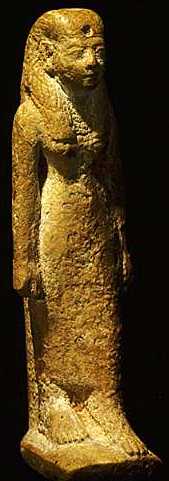



At this first stage of our analysis, we can already sum the situation up to a certain degree: what we have here is a statue of a woman of very small proportions, carved in a coarse material by a skilled artist who, however, was not blessed by genius. This data can furnish us with a basis to attempt to date the work: there exists a period where small-size statuettes were preferred to the large figures of former times, and where artists were appreciated more for the skill with which they executed a work than for the ingenuity of their creation. That era is the Late Period (Dynasties 21 to 30, that is 1085 to 333 BC), and more particularly, Dynasties 25 and 26, known as the Saite period (751 to 525 BC).
Closer scrutiny confirms our hypothesis: the figure's archaist pose, its rigidity, its conventional nature - all bear witness to an attempt to return to the plastic language of the first dynasties. For the duration of two centuries, this backward-looking artistic attitude represented the basis of Egyptian aesthetics. Our stranger is reminiscent of the female figures shown bearing offerings for the mastabas, or certain wives of the officials who made a name for themselves during the reigns of the various rulers - Sahouré, Teti, and the Pepis I and II (Dynasties 5 and 6, 2565-2265 BC).
However, the resulting plastic qualities of our woman figure are as far from those of her illustrious ancestors as are the Neo-Gothic works, produced during the reign of Charles X, from the great cathedrals of the original Gothic period. The comparison is not unreasonable: under Psamtik I, just as under Charles X, the tarnished image of the throne and state could only be re-embellished by resorting to the models of great times past. This desperate attempt to revive a system considered obsolete, to justify royal prerogatives through former glory, is one of the most significant features of the so-called Neo-Memphite school.
At this second stage of our analysis, we can ascribe an almost certain date to our statuette - Dynasties 25 and 26 - and a site of origin, namely the Saite workshops. Shall we attempt to delve even further into its past? Might we discover what function this woman served, or even her name?


This brings us to the conclusion of our analysis: to all appearances, this is a statuette from the Saite period, representing the priestess Chapenoupet III. Perhaps, someday, new discoveries concerning this period may invalidate our results. The point of this exercise, however, is to show how a strictly methodical analysis of a monument, no matter how modest a piece, can - with a minimum of knowledge and logic - throw light on the basic character of an entire era.